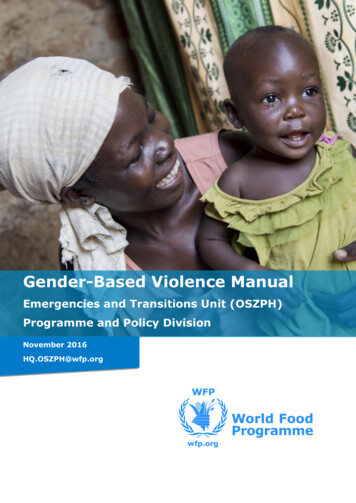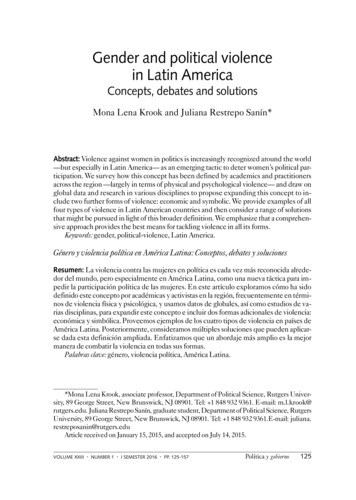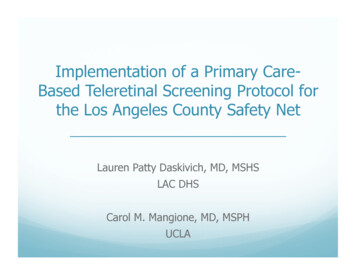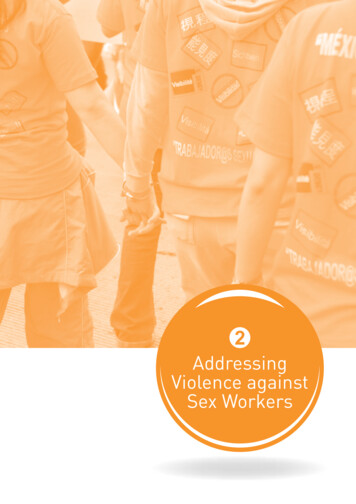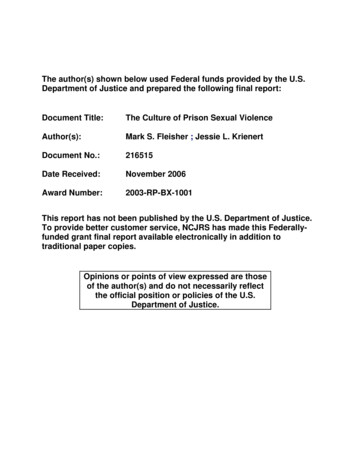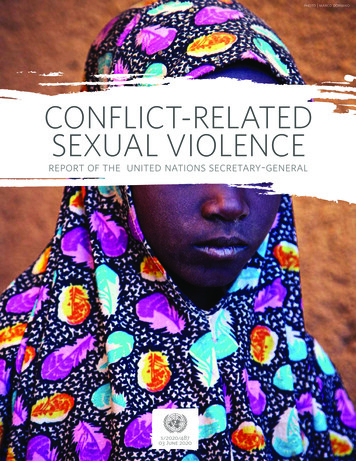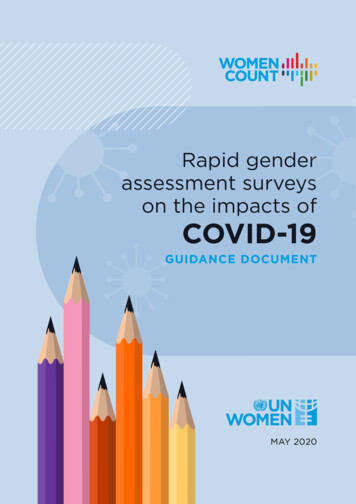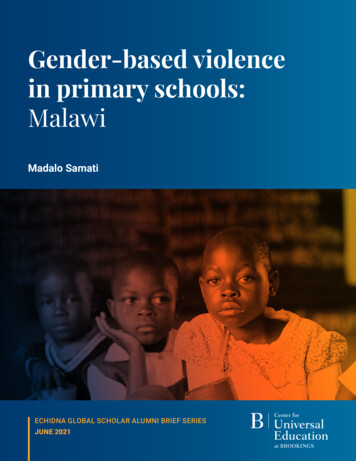
Transcription
Gender-based violencein primary schools:MalawiMadalo SamatiECHIDNA GLOBAL SCHOLAR ALUMNI BRIEF SERIESJUNE 2021
Gender-based violence in primaryschools: MalawiMadalo Samati was an Echidna Global Scholar in 2014. She holds an M.A. insustainable international development from Brandeis University and a B.A. in thehumanities from Chancellor College at the University of Malawi.AcknowledgementsThe Brookings Institution is a nonprofit organization devoted to independentresearch and policy solutions. Its mission is to conduct high-quality, independentresearch and, based on that research, to provide innovative, practicalrecommendations for policymakers and the public. The conclusions andrecommendations of any Brookings publication are solely those of its author(s)and do not reflect the views of the Institution, its management, or its otherscholars.Brookings Institution1
INTRODUCTIONGender-based violence (GBV) is the most pervasive yet least recognized humanrights violation in the world (Heise, Ellsberg, and Gottmoeller 2002). No longeronly a general community issue, GBV has also infiltrated social places such asschools.Despite numerous interventions to curb GBV in general, and school-relatedgender-based violence (SRGBV) in particular, cases of sexual, physical, andemotional abuse are escalating in Malawi. This worrisome situation hasunfortunately rendered futile the Malawi government’s positive gender policyframework and past GBV interventions by local nongovernmental organizations.Studies on SRGBV in Malawi report that cases of abuse and violence relate to theage and sex of victims. Violence and abuse mostly target the young and females(Bisika 2009; Burton 2005). In the Malawian education sector specifically, theresearch on sexual violence in primary schools has been inadequate. Thus, thisstudy focused on primary education to ascertain the prevalence, patterns, andways of dealing with SRGBV in Malawian primary schools. Could SRGBV affectstudents’ school performance, their ability to focus, and their ability to learn?This report presents findings from Malawi for a study that was also conducted inKenya, Jamaica, and Nigeria. Figure 1 summarizes the key findings from theMalawian study.Brookings Institution2
Figure 1. School-related gender-based violence (SRGBV) in Malawianprimary schools: Key findings About 70 percent of students in the study have experienced SRGBV. Students in the Chikwawa District were more likely than in other districtsto experience SRGBV. Nearly 20 percent of the students said mode of dressing fuels SRGBV. About 19 percent of the students do not know the causes of SRGBV. Nearly 17 percent said poverty, money, gifts, and favors fuel SRGBV.PrevalenceCauses Timing of SRGBV: breaks, assemblies, sports. Locations of SRGBV: toilets, bushes, empty classrooms. Forms of SRGBV: touching, kissing, joking, bullying. Perpetrators of SRGBV: 72.5 percent were abused by schoolmates.Patterns About 65 percent of students were depressed after SRGBV encounters. Many students lived in fear or changed school routines after SRGBV.Effects Many students said teachers, administrators, and parents can stop SRGBV. Nearly 70 percent of the surveyed teachers were not trained in SRGBV. Orient teachers on SRGBV management. Sensitize students on the causes of SRGBV. Mobilize communities to eradicate SRGBV.ManagingInterventionSource: Author’s compilation from field survey, 2020.Brookings Institution3
Common study background andmethodologyAs noted earlier, this study is part of a larger cross-country study of SRGBV inprimary schools that includes Jamaica, Kenya, Malawi, and Nigeria.1ObjectivesThe “common study” held three specific research objectives: Establish the prevalence of and possible factors leading to SRGBV Determine country response options to the challenges posed by SRGBV Identify possible interventions toward minimizing SRGBV.The research applied a mixed methods design (Creswell 2013), includingquantitative surveys, qualitative focus group discussions (FGDs), and a deskreview targeting girls and boys of primary school age (10–13 years) as well aseducators in selected primary-level institutions, including guidance counselors,head teachers, and teachers.Malawi-specific methodologyAlthough the other countries in the study focused on the age range of 10–13years, the Malawian study had to extend it to students aged 17 years. This wasunavoidable because it is common to find learners around that general age inMalawian primary schools. This situation is driven by post-pregnancy admissionsand repetitions, among other factors. It was important that this study include thebroader age range to understand more fully the prevalence, causes, andexperiences of SRGBV in primary schools. The study involved 600 students and36 teachers at 16 primary schools, of whom 287 were boys (48 percent of thetotal sample) and 313 were girls (52 percent of the total sample).—1A policy brief synthesizing the cross-country findings is forthcoming. The three country briefs are availablehere: der-based-violence-in-primary-schools/.Brookings Institution4
The study covered all the three regions of Malawi. The Northern, Central, andSouthern Regions were represented by Chitipa, Ntchisi, and Chikwawa andThyolo Districts, respectively. For this report, findings are deduced fromquestionnaires administered to the 600 students. Where necessary, thequestionnaire findings were corroborated by FGDs with the same students aswell as by stories they told themselves. (Some of them were victims of SRGBVand had dropped out of school.) We further corroborated the student findingswith responses from questionnaires administered to the 36 teachers. Descriptivestatistics were used in the analysis of the numerical data, while thematic analysiswas employed in the analysis of the textual data.Key messages from the researchfindingsNo. 1: Prevalence of SRGBV in Malawian primary schools isextremely highMalawi has an overall SRGBV prevalence of about 70 percent in primary schools,cutting across sex, age group, and region. And its prevalence in the primaryschools has no boundaries—that is, it exists in all the research districts andprimary schools. Student SRGBV experiences by region showed that morestudents in the Southern Region’s Chikwawa District (66.7 percent) than in theother districts have faced sexual violence and/or harassment.Bullying might be fueling SRGBV in Malawian primary schools. The Malawianstudy found that 413 out of the 600 students involved in the study were bullied in2019, a prevalence of 69 percent. Although quite shocking, this prevalence is notsurprising because important stakeholders tend to accept SRGBV in schools(Samati 2013).2 Figure 2 shows the prevalence of SRGBV in Malawi, by region,averaged from reports of five forms of SRGBV: sexual, physical, verbal,psychological, and emotional abuse. Specifically, we zeroed in on SRGBV in order—2Discriminatory attitudes and practices against girls by teachers in the classroom and school Administratorsand peers in the wider school environment were noted as deep and adverse.Brookings Institution5
to measure the following incidents: made unwelcomed sexual comments,showed sexy or sexual pictures, touched in unwelcome sexual ways, exposedbody or showed naked pictures, forced to do something sexual, and bullying.Figure 2. Prevalence of SRGBV in Malawian primary schools, byregion10090SRGBV prevalence strictsSource: Author’s computation from field study, 2020.Note: The sample included 600 primary school students, aged 10–17 years, from 16 primary schools. Fiveforms of school-related gender-based violence (SRGBV) were measured: sexual, physical, verbal,psychological, and emotional abuse. The overall prevalence of SRGBV was averaged from responsesregarding all five forms.Brookings Institution6
No. 2: Boys are most likely to encounter the more verbal forms ofSRGBV, while girls are most likely to encounter the more detrimentalphysical forms of SRGBVOn average, boys and girls in Malawian primary schools face SRGBV at roughlythe same rate: 54.6 percent of girls and 55.3 percent of boys. Where significantgender differences emerge is in the forms of SRGBV experienced by boyscompared with girls—the verbal forms for boys (20 percent of boys and 18percent of girls encountered unwelcomed sexual comments) and the physicalforms for girls (14 percent of girls and 10 percent of boys were touched in anunwelcome sexual way; and 12 percent of girls and 4 percent of boys wereforced to do something sexual).Students of all age groups are vulnerable to SRGBV, but the older ones (from 13years) are more vulnerable. Students who are 17 years and older are the mostlikely (23 percent) to have had someone touch them in an unwelcome sexualway, followed by those aged 13–16 years (14 percent) and those aged 9–12years (8 percent).In addition, physical violence could not be separated from SRGBV. For example,most victims of SRGBV indicated during the FGDs that they had experiencedforced touching, kissing, and hugging, usually involving physical force. Fightsalso were often cited during the FGDs. The fights usually led to SRGBV, especiallywhen they were between students of the opposite sex. Physical violence wasalso observed by teachers, who indicated that they usually discipline students forfighting.No. 3: Most perpetrators of SRGBV in primary schools in Malawi arethe victims’ schoolmatesOf those students who reported having experienced SRGBV, 73 percent—acrossall age groups, genders, and regions—indicated the abuse had come fromschoolmates. Other perpetrators specified by the students included a neighbour,a family member and a person of authority. The differences between the regions,age groups, and genders are narrow. This suggests that most of the SRGBV isorchestrated by schoolmates.Brookings Institution7
The mapping performed for the study shows that incidents of SRGBV commonlyhappen in toilet areas, bushes, empty classrooms, and boreholes. For example, atNachiwe Primary School in Chitipa District, both girls and boys cited a schoolborehole as one common place where SRGBV occurs. Figure 3 summarizesthese patterns.Figure 3. When, where, and how SRGBV occurs in Malawian primaryschoolsTIMING OF SRGBVbreaksassembliessportsLOCATIONS OF SRGBVtoilet areasbushesempty classroomsIdentifiable patternsboreholesof SRGBV in primaryschools in MalawiFORMS OF SRGBVtouchingkissingjokingFORMS OF BULLYINGphysical violencesexual harrasmentverbal threatsSource: Author’s compilation from field study, 2020.Note: The sample included 600 primary school students, aged 10–17 years, from 16 primary schools.SRGBV school-related gender-based violence.No. 4: Understanding of the causes of SRGBV reflects genderdifferencesPrimary school pupils in Malawi view improper dressing as fueling SRGBV. Bothgirls and boys mentioned mode of dressing as the major cause of SRGBV in theirschools. However, the pupils’ responses also suggest a potential normalizationof SRGBV. The almost even spread of reporting about causes (figure 4) and thehigh incidence of “I don’t know” responses (19 percent) suggest that studentsare normalizing messages about why violence is justifiable—such as because ofpoverty and sexual favors for money, uncontrollable sexual desires, lack ofmentoring, and so on.Brookings Institution8
Figure 4. Responses of Malawian primary students on the causes ofSRGBV, by genderNumber of student responses2520151050Girls (%)Boys (%)Source: Author’s computation from field study, 2020.Note: The sample included 600 primary school students, aged 10–17 years, from 16 primary schools.SRGBV school-related gender-based violence.That “mode of dress” is the most-cited cause also reveals discrepancy andinconsistency with other findings, such as the high prevalence of SRGBV againstboth boys and girls. (Such a response clearly reflects a gendered understandingand normalization of violence—for example, assuming or associating that victimsof SRGBV are girls rather than boys, and then “blaming” girls for the violence theyhave received because they are “asking for it” with provocative styles of dress.)Yet we see from the study findings that bullying is the most-cited type of SRGBVbeing reported—and this was higher among boys than girls.In addition, the study found that sexual-related gender-based violenceperpetrated against girls is less prevalent than against boys. Most boys facedunwelcome sexual comments, whereas many girls were more likely to betouched in unwelcome sexual ways. Given these findings, one would think thatBrookings Institution9
students would be reporting causes of violence consistent with the types ofviolence they are reporting. That the study findings point to mode of dress as theprimary cause suggests that participants tend to view the causes of SRGBVthrough a “blame the girls for their dress” lens. This reveals how children andyouth are socialized to understand SRGBV as sexualized violence, primarilyagainst girls.No. 5: Most students take no action after incidents of SRGBVAmong those students who took action, little or nothing was done to help themredress the harassment. The study found that 99.2 percent of the studentsinvolved in the study (both males and females) in all the four regions did not talkto a counselor or supervisor after incidents of SRGBV.Male students preferred instead to report incidents to teachers, while femalestudents opted to tell family about SRGBV experiences. The study found that 30percent of male victims talked to teachers or fellow students about suchexperiences, while 48.6 percent of female victims talked to family or friendsabout it—most of them (94 percent) changed school routines e.g., skippedclasses. Many older students (13-16-year olds) handled SRGBV situations bythemselves, while younger students (9-12-year olds) reported the incidences tofamily.The study also found that 97.7 percent of the male students and 94.8 percent offemale students failed to report SRGBV because the harasser had more powerand could harm them. This suggests that students must be encouraged to reportSRGBV to redress and eliminate the abuse.No. 6: Institutional resources, processes, and protocols areinsufficient to manage SRGBV in Malawian primary schoolsBecause most cases of SRGBV happen in school locations, perhaps teachers arethe best placed figures to be referral authorities. This is what students saidduring the FGDs. As for whether teachers have handled SRGBV issues amongstudents, 86.1 percent of the students reported yes and 13.9 percent reported no.This suggests that most teachers handle SRGBV issues.Brookings Institution10
Nevertheless, when the teachers were asked whether they have had training onhandling SRGBV, 30.6 percent said yes and 69.4 percent said no—indicating thatmost of the teachers, whom the students depend on, might not handle ormanage SRGBV effectively. This means that many cases of SRGBV are referredto the teachers, but the teachers are seldom trained in SRGBV management.RecommendationsMalawi’s high prevalence of SRGBV relative to Kenya, Jamaica, and Nigeria /gender-based-violence-inprimary-schools/) indicates a degree of normalization of these offenses inMalawi; that SRGBV is hardly being addressed; and, to the extent that it is beingaddressed, the existing SRGBV interventions may be of less effect in Malawi thanin the other three study countries.This research reaffirms that the school environment plays a role in bothreinforcing the gender stereotypes found in the wider society and in socializingstudents through the informal rules and norms it upholds. And that teachers arealso gender actors who often show ignorance or ambivalence toward SRGBV(Samati 2013). The following recommendations emerge from the Malawianstudy findings.Students Orient students to be aware of their rights, duties, and responsibilitiesrelated to SRGBV. Sensitize students on what constitutes SRGBV and how to report incidentsof SRGBV. Using established school protocols, guide and counsel students who haveencountered cases of SRGBV. Include ways of addressing SRGBV issues in student activities.Brookings Institution11
Use student-friendly services such as clubs, debates, and quizzes inschools to improve their knowledge and reporting of SRGBV. Help students to develop SRGBV survival mechanisms (for example,walking in groups).Schools and teachers Orient schools to have reporting structures for SRGBV. Train and mobilize teachers to manage SRGBV redress. Train head teachers on protocols to prevent and deal with SRGBV. Incorporate SRGBV into teacher professional development. Mandate that schools and teachers ensure that the locations studentspatronize are well secured.Parents and communities Sensitize parents on how to follow up on SRGBV. Mobilize communities to act against SRGBV. Guide parents and communities on how to refer students whoexperienced SRGBV. Include SRGBV awareness in community activities. Mobilize communities to set bylaws punishing GBV perpetrators at thecommunity level. Empower parents and communities to ensure that school pathways aresafe.Overall, SRGBV has been normalized by students and teachers given its deeproots in people’s values and practices. As a result, there is a need to develop andimplement systematic, age- and gender-specific communications andBrookings Institution12
interventions for normative and behavioral change that sensitize, motivate, andempower students, teachers, parents, and community leaders to eliminate theseabuses with a lasting impact.ConclusionThe Malawian study SRGBV in primary schools found that despite its highprevalence, most of the primary education stakeholders are unaware of itscauses, effects, and ways of managing it in schools. The study also found thatmost of the key stakeholders in primary schools (particularly teachers) lackexpertise on handling and dealing with cases of SRGBV. Furthermore, the currentmechanisms and interventions to manage and curb SRGBV are ineffective.Without such interventions, as the study revealed, many incidents of SRGBVpersist throughout unsafe areas of Malawian primary schools where many of theincidents occur.Among other recommendations, there is a need to expand the advocacy onSRGBV to include boys since they are also victims. It had been widely believedthat girls are more likely than boys to face sexual harassment or any form ofSRGBV. However, new evidence from this research challenges this belief. Itspeaks to the need to design SRGBV interventions that are inclusive of both boysand girls and are also sensitive to age and culture.This report also points to how a culture of SRGBV is proliferating violence to thepoint of negatively affecting both girls and boys (manifesting as depression,dropouts, and loss of concentration). This finding has grave implications for thecountry’s ability to improve the quality of education and thus educationaloutcomes.The recommendations from students and teachers indicate that close andproductive relationships between teachers and students, and between parentsand communities, could help all stakeholders to find amicable ways of resolvingthe GBV that erupts in schools but eventually extends to homes andcommunities. Thus, the issue of bullying and SRGBV calls for a systematic reviewof current ways of dealing with perpetrators—from no action or corporalpunishments to counseling, parental involvement, and comprehensiveBrookings Institution13
communication on social and behavioral change that also strengthens referralservices. The importance of linking school-based GBV interventions withcommunity action cannot be overemphasized.Brookings Institution14
ReferencesBisika, Thomas. 2009. “Gender-Violence and Education in Malawi: A Study ofViolence against Girls as an Obstruction to Universal Primary SchoolEducation.” Journal of Gender Studies 18 (3): 297–94.Burton, Patrick. 2005. Suffering at School: Results of the Malawi Gender-BasedViolence in Schools Survey. Pretoria, South Africa: Institute for SecurityStudies.Creswell, John W. 2013. “What Is Mixed Methods Research?” YouTube video,15:04, https://www.youtube.com/watch?v 1OaNiTlpyX8.Heise, Lori M., Mary Ellsberg, and Megan Gottmoeller. 2002. “A Global Overviewof Gender-Based Violence.” International Journal of Gynecology &Obstetrics 78 (Suppl 1): S5–S14.Samati, Madalo. 2013. Edited by Xanthe Ackerman and Negar Ashtari Abay “Atthe Interface of Policy and Cultural Change: Engaging Communities inSupport of Girls’ Education in Malawi.” Working Papers from the 2013Echidna Global Scholars, Center for Universal Education at Brookings,Washington, DC.Brookings Institution15
statistics were used in the analysis of the numerical data, while thematic analysis . body or showed nake
